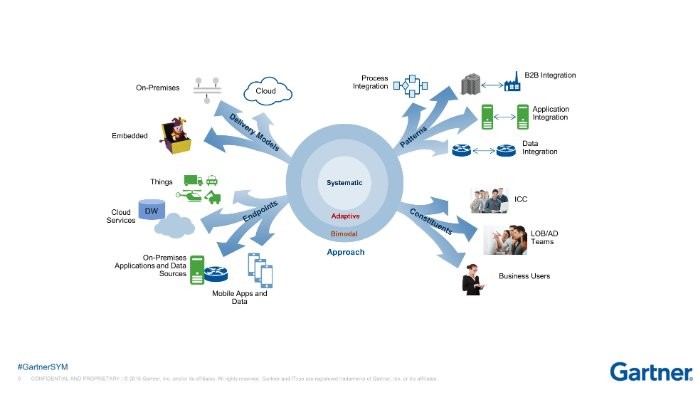
CIO Call to Action: Shake Up Your Integration Strategy to Enable Digital Transformation
On November 26, 2015 Benoit Lheureux, Keith Guttridge and I published this research, which is a call to action for CIOs: They have to rethink their integration strategy if the are to succeed with their digital transformation strategy. A move toward do-it-yourself, self-service pervasive integration carried out by specialists and nonspecialists - including LoB developers, SaaS administrators, data analysts and business users - is imperative to support strategies such as digital business, bimodal IT, post-modern ERP and analytics. The research also features two notable case studies from Eni and Adobe.
Below a summary of the main findings. Enjoy!
What's Going On:
-
Integration can be a source of competitive differentiation and an enabler for bimodal IT, but most CIOs have yet to recognize that their traditional, established integration strategies cannot cope with digitalization's fast technology innovation and accelerated pace of business.
-
The separation between application, data, B2B, cloud service, mobile app and IoT integration technologies and skills is unsustainable. Most new projects must tackle a mix of these issues.
-
Pervasive, "good enough" do-it-yourself (DIY) integration by LOBs and business users is needed for Mode 2 agility. Enabling tools are widely available, but DIY integration poses governance, security, compliance and cultural challenges, and introduces technical debt risks.
-
New providers targeting DIY integration defy the status quo. Integration technology from traditional players is no longer the safest choice and may harm short-term productivity.
What Should You Do:
-
Make the re-envisioning of your integration strategy a top priority, because a holistic, pervasive and "low touch" bimodal integration approach is an entry ticket to the digital era.
-
Encourage and enable DIY integration by setting up support and guardrails for nonspecialists in integration through a "facilitation team" that complements the fulfillment role of traditional centralized integration teams.
-
Encourage and assist application development project leaders into a design-for-interoperability approach by pushing an API-first style supported by appropriate technology.
-
Build up, incrementally, a hybrid integration platform (HIP) hat incorporates capabilities for integration specialists, LOB developers and business users in a self-service fashion.
-
Select integration providers for your HIP pragmatically and with an open mind. Incumbent integration providers may not be ready and emerging players may not yet be enterprise-capable.
Find the full research here (Warning: You must be a Gartner client to access the document)
Group Vice President, Product Marketing at Informatica
6yYou make some interesting observations. I would emphasize that to tackle the myriad of issues you mention with digital transformation related projects it helps to adopt a holistic platform designed to work together for all types of users and fulfills requirements across application, data, B2B, cloud service, mobile app and IoT integration technologies while addressing governance, security, compliance and cultural challenges. As organizations build out HIP incrementally they should look to vendors that have a strong metadata management plus AI (artificial intelligence) foundation so that more automation, guided self-service, and efficient collaboration is available to integration specialists, LOB developers and business users. I highly recommend viewing Amit Walia’s Informatica World 2017 keynote presentation on “Realizing Intelligent Transformation” at https://www.youtube.com/watch?v=ij7Nvm0ojU0&list=PLDQNKHReEhj9PaGC_4PdmhMaTnzdYBoRV&index=2
Driving B2B SaaS marketing with data driven customer-centric GTM strategies and agile execution.
6yThanks Massimo Pezzini. Very informative summary and relevant to what we are seeing in our customer base. A recent presentation by Keith Guttridge at Informatica World '17 highlights few Informatica customer stories how they are building agile IT strategies to support the next generation of iPaaS/Hybrid Integration Platform and Self-Service model - http://www.informaticaworld.com/iw17/documents/Industry%20Perspectives_Cloud_Hybrid_FINAL.pdf
Co-Founder & CEO @ APIANT / Filmmaker
6yExcellent Massimo Pezzini! Integration is IMO the single most important challenge for CIOs today and probably the most overlooked in the last few years. APIs are just part of the equation and in most cases, one must include an integration partner (iPaaS) in their strategy to handle the proliferation of APIs and constant changes to these APIs. Determining which is the right partner is part of that challenge. Security, agility, inventory of APIs, speed to implement, granular control of connectors are just some of the considerations. Would you agree?
Specialist Leader at Deloitte
6yvery nice article
AutoDeploy CEO -- Bringing DevOps to the Enterprise.
7yRethinking traditional integration methods are critical for creating new opportunities and new outcomes for every organization. Nice post!